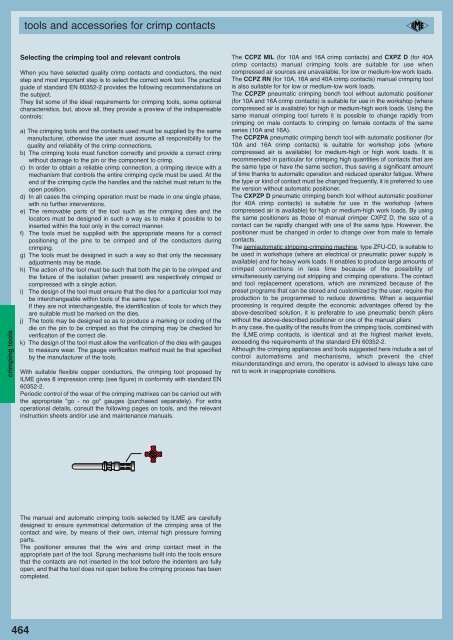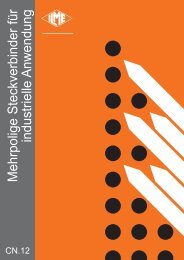20111104_CN.12_complete_UK_LOW.pdf
Create successful ePaper yourself
Turn your PDF publications into a flip-book with our unique Google optimized e-Paper software.
crimping tools<br />
464<br />
tools and accessories for crimp contacts<br />
Selecting the crimping tool and relevant controls<br />
When you have selected quality crimp contacts and conductors, the next<br />
step and most important step is to select the correct work tool. The practical<br />
guide of standard EN 60352-2 provides the following recommendations on<br />
the subject.<br />
They list some of the ideal requirements for crimping tools, some optional<br />
characteristics, but, above all, they provide a preview of the indispensable<br />
controls:<br />
a) The crimping tools and the contacts used must be supplied by the same<br />
manufacturer, otherwise the user must assume all responsibility for the<br />
quality and reliability of the crimp connections.<br />
b) The crimping tools must function correctly and provide a correct crimp<br />
without damage to the pin or the component to crimp.<br />
c) In order to obtain a reliable crimp connection, a crimping device with a<br />
mechanism that controls the entire crimping cycle must be used. At the<br />
end of the crimping cycle the handles and the ratchet must return to the<br />
open position.<br />
d) In all cases the crimping operation must be made in one single phase,<br />
with no further interventions.<br />
e) The removable parts of the tool such as the crimping dies and the<br />
locators must be designed in such a way as to make it possible to be<br />
inserted within the tool only in the correct manner.<br />
f) The tools must be supplied with the appropriate means for a correct<br />
positioning of the pins to be crimped and of the conductors during<br />
crimping.<br />
g) The tools must be designed in such a way so that only the necessary<br />
adjustments may be made.<br />
h) The action of the tool must be such that both the pin to be crimped and<br />
the fixture of the isolation (when present) are respectively crimped or<br />
compressed with a single action.<br />
i) The design of the tool must ensure that the dies for a particular tool may<br />
be interchangeable within tools of the same type.<br />
If they are not interchangeable, the identification of tools for which they<br />
are suitable must be marked on the dies.<br />
j) The tools may be designed so as to produce a marking or coding of the<br />
die on the pin to be crimped so that the crimping may be checked for<br />
verification of the correct die.<br />
k) The design of the tool must allow the verification of the dies with gauges<br />
to measure wear. The gauge verification method must be that specified<br />
by the manufacturer of the tools.<br />
With suitable flexible copper conductors, the crimping tool proposed by<br />
ILME gives 8 impression crimp (see figure) in conformity with standard EN<br />
60352-2.<br />
Periodic control of the wear of the crimping matrixes can be carried out with<br />
the appropriate "go - no go" gauges (purchased separately). For extra<br />
operational details, consult the following pages on tools, and the relevant<br />
instruction sheets and/or use and maintenance manuals.<br />
The manual and automatic crimping tools selected by ILME are carefully<br />
designed to ensure symmetrical deformation of the crimping area of the<br />
contact and wire, by means of their own, internal high pressure forming<br />
parts.<br />
The positioner ensures that the wire and crimp contact meet in the<br />
appropriate part of the tool. Sprung mechanisms built into the tools ensure<br />
that the contacts are not inserted in the tool before the indenters are fully<br />
open, and that the tool does not open before the crimping process has been<br />
<strong>complete</strong>d.<br />
The CCPZ MIL (for 10A and 16A crimp contacts) and CXPZ D (for 40A<br />
crimp contacts) manual crimping tools are suitable for use when<br />
compressed air sources are unavailable, for low or medium-low work loads.<br />
The CCPZ RN (for 10A, 16A and 40A crimp contacts) manual crimping tool<br />
is also suitable for for low or medium-low work loads.<br />
The CCPZP pneumatic crimping bench tool without automatic positioner<br />
(for 10A and 16A crimp contacts) is suitable for use in the workshop (where<br />
compressed air is available) for high or medium-high work loads. Using the<br />
same manual crimping tool turrets it is possible to change rapidly from<br />
crimping on male contacts to crimping on female contacts of the same<br />
series (10A and 16A).<br />
The CCPZPA pneumatic crimping bench tool with automatic positioner (for<br />
10A and 16A crimp contacts) is suitable for workshop jobs (where<br />
compressed air is available) for medium-high or high work loads. It is<br />
recommended in particular for crimping high quantities of contacts that are<br />
the same type or have the same section, thus saving a significant amount<br />
of time thanks to automatic operation and reduced operator fatigue. Where<br />
the type or kind of contact must be changed frequently, it is preferred to use<br />
the version without automatic positioner.<br />
The CXPZP D pneumatic crimping bench tool without automatic positioner<br />
(for 40A crimp contacts) is suitable for use in the workshop (where<br />
compressed air is available) for high or medium-high work loads. By using<br />
the same positioners as those of manual crimper CXPZ D, the size of a<br />
contact can be rapidly changed with one of the same type. However, the<br />
positioner must be changed in order to change over from male to female<br />
contacts.<br />
The semiautomatic stripping-crimping machine, type ZFU-CD, is suitable to<br />
be used in workshops (where an electrical or pneumatic power supply is<br />
available) and for heavy work loads. It enables to produce large amounts of<br />
crimped connections in less time because of the possibility of<br />
simultaneously carrying out stripping and crimping operations. The contact<br />
and tool replacement operations, which are minimized because of the<br />
preset programs that can be stored and customized by the user, require the<br />
production to be programmed to reduce downtime. When a sequential<br />
processing is required despite the economic advantages offered by the<br />
above-described solution, it is preferable to use pneumatic bench pliers<br />
without the above-described positioner or one of the manual pliers<br />
In any case, the quality of the results from the crimping tools, combined with<br />
the ILME crimp contacts, is identical and at the highest market levels,<br />
exceeding the requirements of the standard EN 60352-2.<br />
Although the crimping appliances and tools suggested here include a set of<br />
control automatisms and mechanisms, which prevent the chief<br />
misunderstandings and errors, the operator is advised to always take care<br />
not to work in inappropriate conditions.




